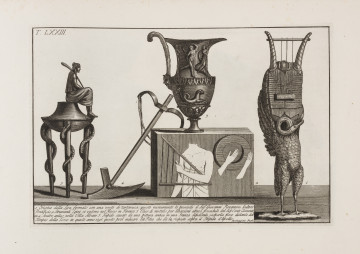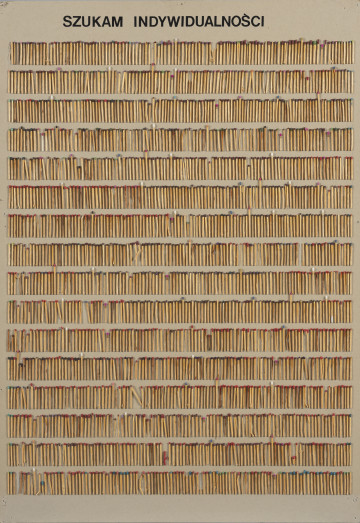
Origine della lira, Strumenti Egizij, Vaso, Aratro antico, Tripode | Prototype of lyre, Egyptian instruments, Vase, Antique colter, Trivet
1804
National Museum in Szczecin
Part of the collection: Post-avant-garde and progressive art
At the heart of Tarshito's work is a belief in the need for spirituality: "Everyone has to discover their own unity. Art is a bridge, a ladder that leads us to higher levels of self-knowledge. Niccola Strippoli (1952- ), an Italian-born architect, open-minded artist and teacher, was given the name Tarshito, which in Sanskrit symbolises the desire for inner knowledge, during a trip to India (1979). It was given to him by Bhagwan Shree Rajneesh, also known as Osho. The controversial Hindu guru, who rejected any religion or belief system, recommended developing personal spirituality through love, active meditation, creative action, joy and celebration. Tarshito quotes his words in the featured work: "I do not understand why there should be so many nations, why there should be so many borders on geographical maps. Let us always remember: they are just lines drawn on a piece of paper. They don't exist anywhere else on earth or in the sky. In Tarshito's work, races and borders disappear, replaced by a single idea that brings peoples, cultures and religions together in unity and brotherhood. In addition to the quoted text, a map without divisions or borders, there is another prominent iconographic element often used by Tarshito. The vase, a symbol of the origin of life, its growth, a metaphor for the void and totality, illustrates what art is for the artist: embracing, overflowing to the point of creative exhaustion, an ongoing process of conceptual and emotional communication. Tarshito's work is a journey open to new challenges, new media, creative techniques, collaborations with other artists, craftsmen, scientists, spiritual guides. He creates paintings, sculptures, ceramics, prints, jewellery, wallpapers, objects and installations. The artist turns to sounds, smells, words. All of this serves to achieve harmony, to reach the audience not only through mental interpretation, but also through interaction and sensory experience. The work I don't understand why... was exhibited at the National Museum in Szczecin during the Tarshito exhibition. Art for a new humanity (2009). Marlena Chybowska-Butler
Author / creator
Object type
painting, diptych
Technique
mixed technique
Material
canvas, acrylic, ink, rubber, wood
Origin / acquisition method
donation
Creation time / dating
Creation / finding place
Owner
Muzeum Narodowe w Szczecinie
Identification number
Location / status

1804
National Museum in Szczecin

1997 — 2004
National Museum in Szczecin

2002
National Museum in Szczecin
DISCOVER this TOPIC
Museum of King Jan III's Palace at Wilanów
DISCOVER this PATH
Educational path